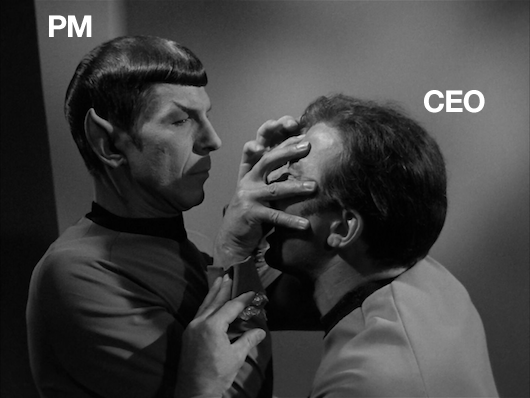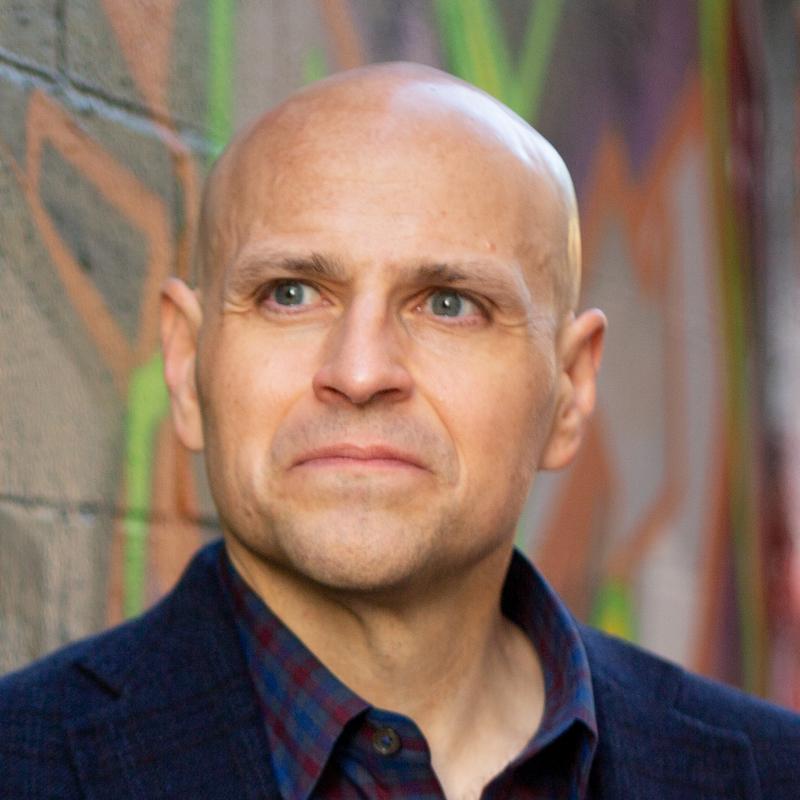
Do you want to kill a product? Have a CEO and product manager with different ideas for where it’s going. If you’re lucky, the disagreement gets resolved and things get back on track. If not, your company dies a million deaths as the power struggle gets played out in the product itself. Everybody loses, users most of all.
More than anyone else at the company, it’s essential that the CEO and the PM be on the same page (or in the case of a bigger company, a general manager or senior product leader). Remember the Vulcan Mind-Meld from Star Trek? That’s where Mr. Spock could touch someone’s head and share their thoughts telepathically. Yeah, it’s like that. Here’s some advice for putting this into practice (without all of the face touching).
Talk about the future. A good Product CEO spends most of their mental energy in the product’s future, not its present. Their vision will change and evolve, and both the PM and the CEO need to stay in sync. The PM needs to keep the team aiming at this north star. Ask the CEO where the product will be in five years or ten years (the best product CEOs will treat those as two separate questions [1] [2]).
Frequent one-on-ones with the CEO. Ideally the CEO and PM are meeting one-on-one weekly. In a smaller company, this should be easy to accomplish. (And don’t let anything get in their way.) Regular private time allows both of you to share unformed ideas, to debate when you disagree, and for you both to share what you’ve learned from your team, your customers, and the product. PMs shouldn’t have to piece together the CEO’s strategy from scattered pieces of cuneiform, they should hear it directly, and regularly.
Find those third rails. There are certain areas of the product that the CEO will be most opinionated and passionate about. The CEO will need to be more involved in these details. Knowing where these “third rails” are will help the PM avoid surprises and front-load debate before code is written.
Make sure the conversation goes both ways. PMs shouldn’t just be the CEO’s implementation lackey. CEOs should listen as much as they talk. PMs shouldn’t restrict the conversation to tactical updates on progress, but about their vision for the future too. After the mind meld you should share thoughts, but not a brain.
Good Reads
“I had to quit to put myself in a position to believe in myself.” My friend Ellen Chisa quit Harvard Business School to join a startup. She shares her best advice about something we rarely discuss: the fine art of quitting. “Saying ‘no’ is a tool to do the few things that matter to you very well.”
Building your business on someone else’s platform can be like strapping yourself to a rocket, but a rocket that could come crashing back to earth. Josh Elman knows platforms from his days at Facebook, Twitter, and LinkedIn, and he shares what he’s learned in this presentation. “Build your product to be independent. Only use the platform for acceleration.”
“You should not torture yourself with any assumed blame.” Bob Ebeling was an engineer at space shuttle contractor Morton Thiokol in 1986. With a handful of other engineers, he argued unsuccessfully that the Space Shuttle Challenger should be grounded due to risks that the O-rings would fail in the freezing temperatures. To his horror, the weakened O-rings ultimately claimed the lives of seven astronauts. Ebeling has carried this burden for more than 30 years. But when NPR’s All Things Considered shared his story, an outpouring of support from listeners, other engineers, and his former colleagues helped him shed years of guilt. Read or listen to this remarkable segment about an engineer’s redemption.
How should you take notes during customer interviews? Teresa Torres shares her advice on everything from whether to record the conversation to why writing your notes by hand might be better than typing.
The New York Times Magazine’s entire weekend issue was dedicated to the future of work. Don’t miss their article on the work-life equation or what Google learned about building the perfect team. “As the researchers studied the groups, however, they noticed two behaviors that all the good teams generally shared. First, on the good teams, members spoke in roughly the same proportion, a phenomenon the researchers referred to as ‘equality in distribution of conversational turn-taking.’ Second, the good teams all had high ‘average social sensitivity’ — a fancy way of saying they were skilled at intuiting how others felt based on their tone of voice, their expressions and other nonverbal cues.”
Gross profit, not revenue is the metric companies should be using to compare themselves to others. So says Tomasz Tunguz, in Not All Revenue Dollars Are Created Equal. “The higher the gross margin, the more revenue can be reinvested in growth, the less money the business must raise to grow, the less dilution incurred.”
“I’ve made some dumb purchases.” There are two essential annual reads for anyone in business: Mary Meeker’s Internet Trends and Warren Buffett’s Shareholder Letter. If you haven’t made a habit of reading Buffett’s letter, which was just sent, now is a good time to start. I recommend this annotated version on Bloomberg.com.
